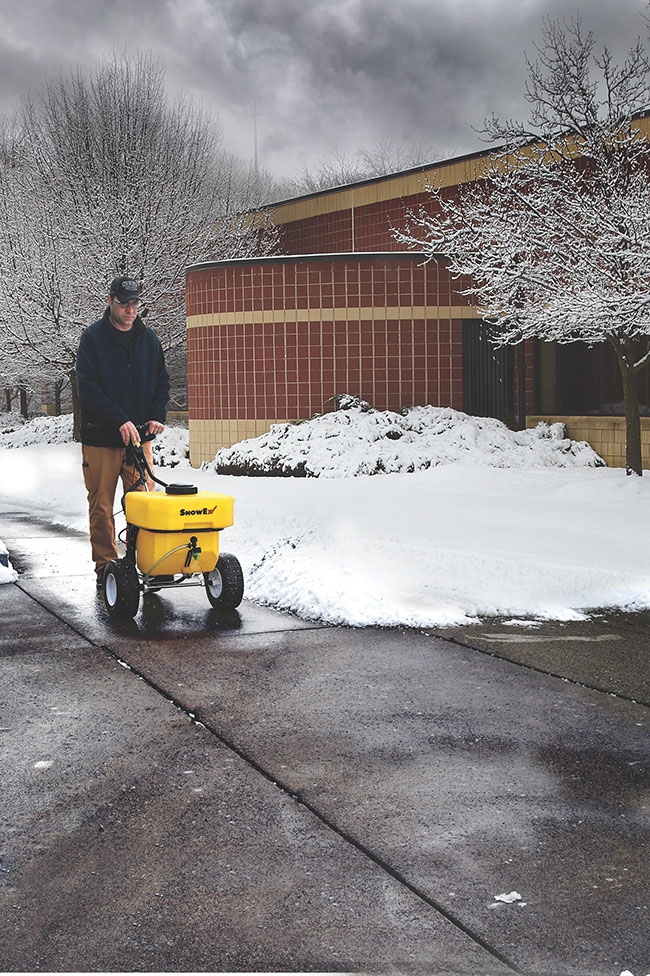
News
Walk the brine
Using liquids to achieve superior sidewalk performance results at less cost
June 10, 2019 By Pam Buckley
 Brine pre-treatments are typically executed one to three days before an event. Schedule your sidewalk applications when there is minimal pedestrian traffic.
Brine pre-treatments are typically executed one to three days before an event. Schedule your sidewalk applications when there is minimal pedestrian traffic. Contractors agree that sidewalks pose some of the biggest challenges in winter maintenance – high labour and high risk. Taking a preventative approach to sidewalk maintenance provides solutions for both of these concerns. It also allows companies that are interested in adding liquids to their operations to start out on a smaller scale.
The objective of anti-icing is to inhibit accumulation from forming an ice bond with the pavement. Brine can be used to prevent that bond before, during and after a storm. The preferred protocol is to apply brine directly to the surface by direct liquid application (DLA). This practice and the way in which it is executed offer a variety of benefits. When just getting started, it is recommended to limit your service areas until you become accustomed to how these materials and practices perform.
When applied prior to a storm, brine waits in the pores of the sidewalk and goes to work as soon as the first snow falls to insulate the surface and to maintain optimum levels of surface friction until the sidewalk can be cleared. Depending on conditions, an effective anti-icing/pre-treatment application will melt the first 0.5 to 1.25 centimetres of snow, after which it maintains a protective slush barrier on the bottom.
Used appropriately as a post-treatment, brine produces faster results and can recover the desired surface conditions faster than dry salt, which takes longer to produce results since it must first go into solution and form brine before it will melt anything. Appropriately used, taking a preventative anti-icing approach reduces the risk of slip-and-fall accidents.
Ideal for sidewalks
Liquids can be applied with precision and stay on the sidewalk until they dry. They are not shoveled, blown or broadcast off the surface where they can damage adjacent landscape. A pre-treatment can last for days on a sidewalk, and because it leaves no excess salt, there is no labour required to clean it up afterward. This results in substantially less tracking into customers’ businesses and damage to entryways and lobby floors.
By shifting sidewalk resources to preventative anti-icing measures, contractors can utilize up to 75 per cent less salt and substantially less labour than what’s required to achieve similar results by de-icing. This can significantly mitigate the damaging impacts of salting on customer properties and the environment, reduce crew fatigue, and decrease overhead costs. Contractors have seen a reduction in the use of bagged product as well as rock salt, thanks to their transition to anti-icing for sidewalks.
Equipment
For sidewalk liquid treatment applications, walk-behind push sprayers and UTV-mounted sprayers offer various pros and cons depending on operating needs and the areas in need of treatment.
Electric-powered push sprayers make for a relatively low-cost investment to get started. They also are extremely portable and easy to maneuver and use on any width of residential walks and driveways. Some models on the market are equipped with an adjustable spray wand for spot-spraying tougher spots to reach, like stairs.
Push sprayers offer a limited tank volume, so users need to have a plan for refilling the tank on site as work continues. The sprayers are also fairly heavy to lift when filled with brine. A good sprayer battery should keep its charge for at least 12 hours for longer working shifts, but it will still require users to be diligent and recharge it frequently.
To step up into brine application on larger jobs, contractors can invest in a UTV-mounted sprayer with greater capacity in the 100-gallon range. This is a great option for applying liquids faster when addressing long stretches of sidewalks and pedestrian walkways wide enough to accommodate a UTV.
These sprayers feature a boom – usually around four feet wide for models being used on a UTV – that allow operators to easily position the nozzles to adjust application rate and spray pattern. Typical nozzle position settings include triple stream, single stream and wide fan. Of course, a UTV may not be able to reach all surface areas that require treatment, so select models will also feature a wand and 50-foot hose for spot spraying those hard-to-reach places like curbs and stairs.
Operational standards
Understanding application rates and best practices is essential to making a successful transition into the use of liquids. Successful brine application is rooted in science, but it takes practice to truly get it right. By refining best practices with experience over time, contractors can develop their own standards based on the unique needs of their operations.
Among the factors to consider is what your contractual requirements are and how much time you have to meet your customer’s expectations. This will determine whether to pre-treat, post-treat or both. The actual makeup of a storm – timing, intensity, pavement temperature, present and anticipated accumulation – will affect the choice of brine, rate, and the timing of its application.
When the temperature drops low enough, the material may stop working and you may need to introduce additional chemicals to increase performance. Salt brine (NaCl) is considered an effective choice for anti-icing down to a pavement temperature of minus 9 degrees Celsius. Suggested application rates increase incrementally as the pavement temperature decreases. Adding a blend of up to 30 per cent calcium or magnesium chloride is necessary to prevent freeze conditions and to expedite results when the pavement temperature drops below minus 9 degrees.
Best practices
Having success with liquids does require some advance preparation before the storm arrives. Using pavement temperature data from the days preceding an event, along with air temperature trends, can help with estimating the pavement temperature range for the event.
This data can then be used to calculate the desired brine makeup and application rate. Store enough brine for a couple applications per site in at least two storms. Establish a standard application rate and calibrate all spraying equipment to that rate.
Pre-treatments are typically executed one to three days before the event. As long as rain is not in the forecast, you can start applying brine and continue up to the start of the storm. A good practice is to schedule your sidewalk applications when there is minimal pedestrian traffic to limit tracking.
Upon arrival on site, unload the equipment and fill the tanks. Check the nozzles and adjust spray to ensure adequate coverage without extending off the sidewalk. Test the pavement temperature to confirm the desired application rate. Then apply the brine and allow it to dry.
On the day of the storm, monitor sidewalks regularly to prevent refreeze and optimize pedestrian safety. Shovel and treat the surface every two hours or after every 2.5 to 4 centimetres of accumulation. Drifting snow and roof buildup falling on walks will require more immediate attention.
Areas like handicapped ramps, stairs, crosswalks, under downspouts and shaded areas may require shorter cycle times or higher application rates. These situations may also call for augmenting the post-treatment with a light application of bagged material to extend the duration of application effectiveness and add traction for pedestrians.
Again check the surface temperature to confirm the application rate, and apply brine immediately after clearing to remove residual snow and prevent ice from bonding to the pavement. De-icing with brine for bonded ice and hard-pack is not recommended. This requires advanced experience, significantly higher rates and high-pressure nozzles capable of penetrating hard-pack.
Sustainable, profitable solutions
Winter sidewalk maintenance remains one of the contractor’s most daunting challenges from both a liability and overhead cost standpoint. Changing to a proactive/preventative approach utilizing liquids is transforming how the industry is tackling that challenge. The use of liquids to anti-ice sidewalks produces safer outcomes for customers, pedestrians, work crews and the environment. Most importantly, the use of liquids is increasing the contractor’s bottom line.
Print this page

